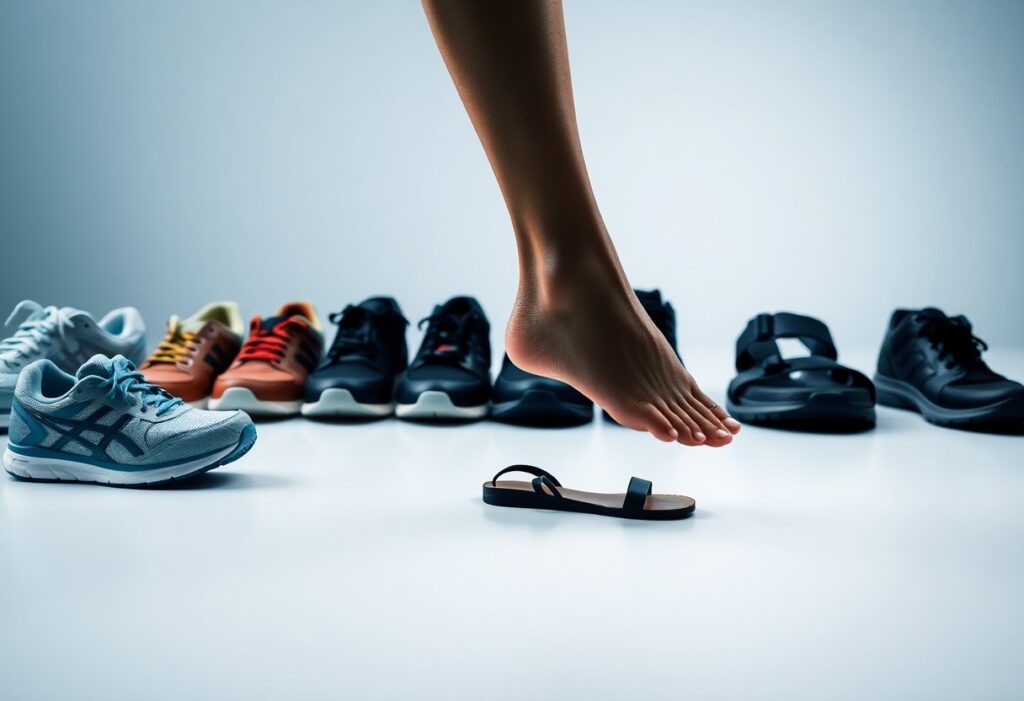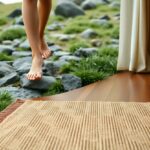
As you navigate through your daily activities, the selection of your footwear plays a pivotal role in either promoting or impairing your foot health. Many people tend to assume that shoes with enhanced cushioning and support provide the best solutions for foot discomfort. However, traditional footwear can often lead to more complications than benefits. Dr. Alissa Kuizinas, a respected podiatrist from Massachusetts, advocates for the use of barefoot shoes or minimalistic shoes, as these styles promote stronger, healthier feet. By choosing footwear that allows your feet to function naturally, you can reduce the risk of developing various foot problems and improve your overall foot wellness.
Recognizing the Limitations of Traditional Footwear Designs
While conventional shoes may provide temporary relief from foot pain, they frequently aggravate pre-existing conditions and introduce new problems, according to Dr. Alissa Kuizinas. She highlights that the $133 billion shoe industry often prioritizes aesthetics over genuine foot health, leading to designs that can constrict and weaken your feet over time. This dependency on traditional footwear sets off a cycle that ultimately deteriorates your foot health, making it essential to rethink your choices.
Examining the Shoe Industry's Misguided Approach to Foot Health
The core issue in this predicament is the shoe industry’s flawed strategy for addressing foot health. This often involves adding excessive cushioning, support, and rigid structures to shoes without addressing the root causes of discomfort. Such an approach can create a reliance on shoes that inadvertently deteriorates your foot health over time, leading to various complications that could have been easily avoided with the right footwear.
Uncovering the Shortcomings of Traditional Shoe Structures
Many traditional shoe designs tend to incorporate narrow toe boxes, stiff soles, and an abundance of cushioning that can restrict natural foot movement. This can result in weak, dysfunctional feet. Dr. Kuizinas argues that footwear should protect your feet from external elements while allowing for natural movement. Ideally, shoes should emphasize natural foot function and include minimalist features, such as wide toe boxes, flexible flat soles, and minimal cushioning, which are essential for promoting foot health.
By opting for barefoot shoes or minimalistic footwear, you have the opportunity to actively strengthen your feet and enhance your overall foot well-being. Dr. Kuizinas encourages adopting a philosophy of utilizing as little shoe as possible, allowing your feet to function naturally and move freely. This is crucial for maintaining healthy foot mechanics and preventing future issues.
The Importance of Allowing Natural Foot Movement
Footwear that limits your foot’s ability to move freely can lead to a wide range of foot issues and discomfort. It is crucial to assess how your shoe choices influence your overall foot health and comfort levels to avoid complications.
Evaluating the Impact of Shoe Design on Foot Mobility
To understand how your footwear affects your foot's mobility, it’s vital to scrutinize the specific designs and features of your shoes. Traditional footwear often incorporates cushioning and support elements that can actually hinder your foot's natural movement, leading to weak and dysfunctional feet over time. This restriction can prevent your feet from developing the necessary strength and flexibility they require for optimal functioning.
Reaping the Benefits of Natural Foot Mobility
Allowing your feet to move naturally offers extensive benefits, as strong feet are essential for overall foot health. By choosing minimalistic shoes or barefoot alternatives, you empower your feet to perform as intended, fostering strength and resilience. Natural movement is crucial for developing strong feet. If your footwear is overly restrictive, you risk developing various foot problems and discomfort. In contrast, embracing minimalistic shoes or barefoot options can significantly boost your foot health by enabling natural movement and promoting strength-building. By selecting appropriate footwear, you can effectively reduce the risk of developing foot issues and enhance your overall foot wellness.
Understanding the Principles of Functional Footwear
It’s essential to gain a comprehensive understanding of functional footwear, as these shoes prioritize both foot health and the promotion of natural movement. Functional footwear is designed specifically to allow your feet to operate as they are intended, eliminating the need for excessive support or confinement.
Defining Functional Footwear and Its Essential Characteristics
Upon exploring various shoe styles and conducting research, you’ll find that functional footwear exhibits distinct characteristics, such as a wide toe box, flat and flexible soles, and minimal cushioning and support. These features enable your feet to move freely and naturally, which is vital for developing stronger foot mechanics.
The Health Benefits of Wearing Functional Footwear
Adopting functional footwear brings numerous advantages, including enhanced foot strength, a reduced risk of injuries, and improved overall foot health. These shoes facilitate your feet in functioning as they were designed, paving the way for stronger feet and better balance in your everyday activities. Conceptually, functional shoes are crafted to support your feet without imposing unnecessary limitations, allowing them to move and flex naturally. This design philosophy fosters optimal foot health while minimizing the likelihood of experiencing foot ailments. By choosing functional footwear, such as barefoot shoes or minimalistic options, you actively promote healthy foot function and mitigate the risk of foot pain and injury. Transitioning to functional footwear may require patience and gradual adaptation, but the long-term benefits for your foot health are immeasurable.
Identifying Key Features for Optimal Functional Footwear
To ensure the best possible foot health, it’s vital to seek out shoes equipped with essential features. The primary attributes to consider include:
- Wide toe box
- Flat and flexible soles
- Minimal cushioning and support
Being cognizant of these characteristics will significantly aid you in selecting shoes that promote healthy foot function and support.
The Significance of Wide Toe Boxes and Flexible Soles
A crucial aspect of functional footwear is a wide toe box, which allows your toes to spread naturally. This design element helps prevent toe jamming and other discomfort-related issues that could lead to chronic foot pain, making it essential for optimal foot health.
Understanding the Role of Minimal Cushioning and Support
In addition to a wide toe box, functional shoes should feature minimal cushioning and support. This design attribute allows your feet to move naturally while strengthening foot muscles, thereby minimizing the risk of foot issues. It’s important to emphasize that minimalistic footwear, including barefoot shoes, can significantly enhance your foot health by allowing your feet to function freely. By choosing shoes with minimal cushioning and support, you can increase the muscle strength in your feet and reduce the chances of injuries. This strategic approach not only improves your overall foot health but also lessens the likelihood of experiencing chronic pain. Therefore, prioritize shoes that enable your feet to move naturally without excessive cushioning or support.
Successfully Transitioning to Functional Footwear
Recognizing the importance of functional footwear is the first step; now it's time to begin your transition. Contrary to the widely-held belief that increased cushioning and support equate to enhanced comfort, you should opt for minimalistic shoes or barefoot shoes that facilitate your feet's natural functioning.
Effective Strategies for Transitioning to Functional Footwear
To ease any concerns, gradually incorporate functional shoes into your daily routine with these practical strategies:
- Begin with short walks and gradually increase the distance
- Choose shoes that feature a wide toe box and flat soles
- Opt for minimal cushioning and support
Allowing your feet the necessary time to adjust to the new footwear is essential for strengthening the muscles in your feet.
Patience and Gradual Adjustment Are Key
The journey to functional footwear requires patience and a gradual approach. Shoes that are excessively minimalist may lead to discomfort or pain, particularly if your feet are not accustomed to them. Starting slowly is critical, giving your feet the time they need to acclimate to the new shoes.
Footwear options like barefoot shoes or minimalistic shoes can greatly enhance your foot health, but it’s vital to introduce them step by step. Overuse or incorrect sizing can result in injuries or persistent discomfort. The ultimate objective is to strengthen your foot muscles while enhancing your overall foot health, so practice patience and avoid rushing the transition. The benefits will be substantial; anticipate experiencing improved balance, reduced pain, and stronger feet.
Building Strong and Functional Feet for Lifelong Wellness
Even in a society that often favors shoes with excessive cushioning and support, you can cultivate strong and functional feet by making informed footwear choices.
The Connection Between Foot Strength and Overall Health
Alongside other health considerations, foot strength is vital for your overall well-being, affecting your balance, posture, and movement capabilities. Strengthening your feet can lead to significant health benefits, including improved agility and stability.
How Functional Footwear Aids in Developing Strong Feet
Functionally designed shoes that incorporate a wide toe box, flat and flexible soles, and minimal cushioning are fundamental to achieving strong feet, as they allow for unrestricted natural movement. Indeed, opting for functional shoes or barefoot shoes can significantly contribute to building stronger foot muscles and enhancing your overall foot health. By allowing your feet to move freely and operate as they should, you can significantly reduce the risk of foot problems and optimize your balance and stability. As you transition to minimalistic shoes, you should look forward to improvements in your walking technique and an overall sense of well-being.
By taking proactive steps to prioritize your foot health, you can choose shoes that support your feet’s natural functions instead of hindering them. Selecting barefoot shoes or minimalistic options that facilitate natural foot movement will aid in strength development over time. This approach will lead to enhanced stability and comfort during your activities, providing your feet the opportunity to become strong and capable. Begin your journey by seeking out shoes with a wide toe box, flat and flexible soles, and minimal cushioning and support, while exercising patience during your transition to a more natural walking style.
The Article A Podiatrist’s Guide to How Shoes Affect Your Foot Health appeared first on My Shoes Finder
The Article How Shoes Impact Your Foot Health: A Podiatrist’s Insights Was Found On https://limitsofstrategy.com






Your discussion about the often-overlooked impact of footwear on foot health is remarkably timely and necessary. I’ve personally had my own journey with footwear choices that echoes what Dr. Alissa Kuizinas advocates. For years, I gravitated toward shoes with thick cushioning, believing that they would keep my feet comfortable during my long walks and workouts. However, I found myself grappling with unexpected foot pain, and it wasn’t until I started researching barefoot and minimalistic shoes that I began to understand how traditional designs could actually be contributing to my discomfort.